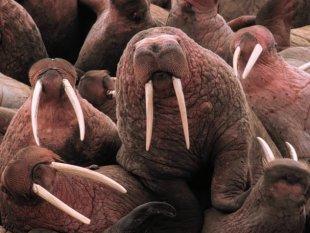 by Suzanne Goldenberg / The Guardian
by Suzanne Goldenberg / The GuardianThe plight of thousands of walruses forced to crowd on to an Alaska beach because of disappearing sea ice has set off an all-out response from the US government to avoid a catastrophic stampede.
The Federal Aviation Authority has re-routed flights, and local communities have called on bush pilots to keep their distance in an effort to avoid setting off a panic that could see scores of walruses trampled to death, federal government scientists told reporters.
Curiosity seekers and the media have also been asked to stay away.
An estimated 35,000 walruses were spotted on the barrier island in north-western Alaska on 27 September by scientists on an aerial survey flight.
The biggest immediate risk factor for the walruses now is a stampede – especially for baby walruses – but they have been facing a growing threat from climate change, the scientists said.
The extraordinary sighting – the biggest known exodus of walruses to dry land ever observed in the Arctic under US control – arrived as the summer sea ice fell to its sixth lowest in the satellite record last month.
“Those animals have essentially run out of offshore sea ice, and have no other choice but to come ashore,” said Chadwick Jay, a research ecologist in Alaska with the US Geological Survey.
Until 2007, it was unheard of for walruses to leave the sea ice for dry land for prolonged periods of time. But the retreat of sea ice has seen “drastic changes” in behavior, Jay said. Walruses have struck out for beaches in six of the last eight years.
He said there was no doubt the migration – or “hauling out” as it is called – was caused by climate change.
“It is really a reduction in the sea ice that is causing the change in behavior, and the reduction of sea ice is due to global warming,” Jay said.
But the immediate concern was to avoid a stampede – a leading risk factor for walruses when they crowd onto beaches and barrier islands.
The FAA is asking pilots to remain above 2,000ft and half a mile away from the walruses. Helicopters – a bigger risk to the walruses because they are noisier – have been asked to remain 3,000ft up and a mile away. News crews, which have been clamoring to film the walruses, have also been asked to stay away. “The government and local communities are respectfully asking you to leave the haul-out alone,” Joel Garlich Miller, a Walrus biologist with the US Fish and Wildlife Service, told reporters.
Walruses are naturally skittish animals, unused to being closely packed together. They also spend 80% of their time on water. Those in the Chukchi sea this time of year are generally females and juveniles and so at greater risk of being trampled to death.
“You have all these animals that are normally distributed on a flat surface. When they lose their sea ice habitat and come ashore in places that are accessible – like flat, sandy beaches – they gather in large numbers, and it becomes like a giant pig pile,” said Margaret Williams, managing director for the World Wildlife Fund’s Arctic program. “When they are disturbed it can cause stampedes in large numbers.”
The walruses were first observed at Point Lay on 12 September, the scientists said. Since that initial sighting of an estimated 10,000 walruses, their numbers have fluctuated – falling to as few as 1,500 on 23 September. However, the scientists cautioned these were very preliminary estimates.
The survey flights have also spotted walrus carcasses on the beach – 50 last week, and another 36 on 27 September. There were signs of both brown bears and polar bears in the area.
Hauling out of walruses have become increasingly frequent since 2000 – as warming creates bigger expanses of open water in the summer months. The US Fish and Wildlife Service is considering expanding protections for walruses as an endangered species.
The sea ice was especially low this year, off Alaska and eastern Siberia, according to the National Snow and Ice Data Center. Summer sea ice cover fell to 1.94m square miles on 17 September, according to the NSIDC, forcing the walruses on to land.
Those forays on to land have frequently proved deadly in the past, because of stampedes and competition for food. Scientists have recorded mass deaths of walruses due to stampedes following such landings in Russia.
“We have seen this phenomenon in terms of high concentrations of walruses that has been occurring on the Russian coast for some time in huge numbers. There are high rates of walrus mortality, especially in calves – babies,” said Williams.
In addition to the stampede risk, it is also much harder for the walruses to hunt from the beach. The walruses typically disperse over large expanses of water, uses ice floes as a platform to hunt for the clams and other shell fish that are their main food source.

